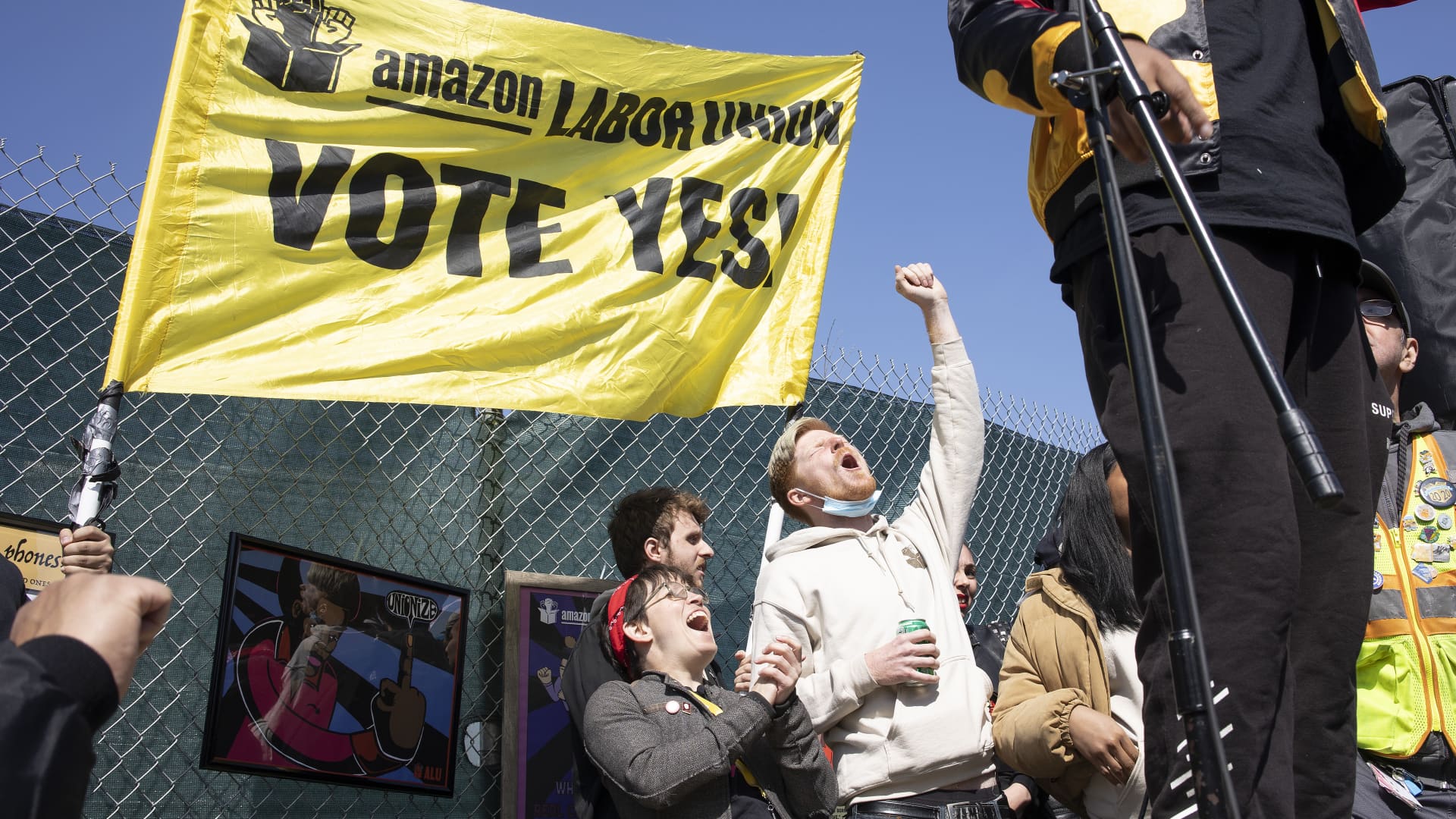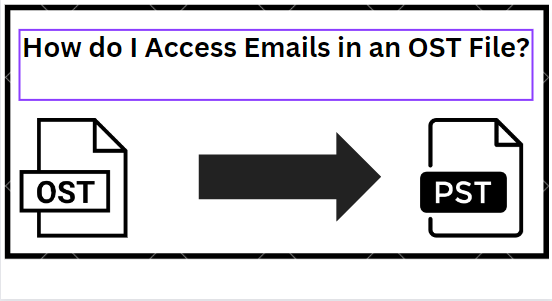The American public is back in love with labor unions, so why aren't workers?
American public support for labor unions has hit a level not seen since 1965, according to Gallup, but among workers, most still don't want to be organized.

Amazon workers at the LDJ5 Amazon warehouse rally in support of the union on April 24, 2022 in Staten Island, New York. The union vote at LDJ5 was defeated on May 2, 2022.
Andrew Lichtenstein/Corbis via Getty Images
As major U.S. corporations from Amazon to Apple, Starbucks and Chipotle face a rising tide of unionization, one of the key questions among labor economists has been whether the headline attention will translate into significant increases in union membership, which has declined in recent decades. New polling from Gallup shows this question remains difficult to answer, even as the issue of unionization, generally, continues to gain momentum.
Public approval of labor unions among the U.S. public is at its highest level since 1965, according to a new Gallup poll released on Tuesday. But only one in six Americans live in a household with a union member, and a majority of nonunion workers in the U.S. (58%) say they are "not interested at all" in joining a union.
"There is clearly increasing general support for unions," said Ben Wigert, director of research and strategy, workplace management at Gallup. But that is more due to the fact that Americans want to put some power back in the hands of employees and improve worker experience and work environment, rather than join the ranks of unions themselves.
Union membership stood at 14 million workers in 2021, representing roughly 10 percent of American workers, a decline from 20% in 1983.
Even as the pandemic has heightened attention on worker conditions, Gallup noted that the net 16% union household figure is within the range (14% to 21%) it has tracked on this data point since 2001.
Interest in joining a union among nonunion members, at 20%, aligns closely with households which currently have a union member, according to Gallup (16%). And the jobs and industries in which there is high interest in unionization continue to be production and front-line roles, Wigert said, where unions are already more likely to exist. That means the data is not showing new interest in union membership outside of traditional unionized jobs.
"That's the thing we are watching and that can be the turning point," Wigert said.
If data holds as is, though, union membership would be 10%-15% of the U.S. workforce and concentrated in heavy union industries.
"But if we see that interest tick up in jobs that have not been unionized, that would be the leading indicator. But we're not actually seeing the individual action change yet," Wigert said. "We would need to see an uptick in either interest among nonunion members in non-traditional roles, or see union members become more attached to their unions. Those would be the signal a sea change is coming, but we're not seeing it yet."
Recent CNBC polling showed higher interest in unionization among employees specifically, than Gallup's poll, with 59% of workers across the U.S. and across all sectors saying they support increased unionization in their own workplaces. That survey also showed that the partisan divide over unions was less than might be expected: 46% of Republicans were in favor of increased unionization at their work.
The partisan gap is narrowing in the Gallup data too, a sign that worker conditions and experience are becoming more of a broad social issue than a political one in American thinking. General approval for unions by political party orientation is typically much higher among Democrats, and remains that way, now at 85%. But Wigert said for the GOP it is usually in the mid-40s, yet now that has bumped up to 56% support. Last year, it was still at 48%.
Other long-term research on worker attitudes about unions shows a slightly better picture of union progress with workers. For several decades starting in the late 1970s, according to research compiled by MIT Sloan School of Management professor Thomas Kochan, only one-third of workers nationally said they would vote "yes" to a union. But in 2017, that number jumped to 48%. "That was the first indication of a big change and all the evidence since has reinforced that," Kochan told CNBC in June.
Kochan said the new Gallup question about interest in a union was asked differently than in his survey research. "When we ask about how one would vote in a union election we are only asking people who are employed in the labor force and we generally exclude high level executives and business owners," he said. That research finds supports at around 50%.
Gallup's surveying of union and nonunion members does show that workers in managerial roles, at 6%, are the least likely to be in a union.
The ways in which union workers are 'stuck'
Gallup's data on job satisfaction also complicates the union battle. Nonunion workers express higher levels of job satisfaction than union members.
Twenty-seven percent of workers who are union members say they are engaged at work, less than the 33% of nonunion members, and Gallup states that this "engagement gap between union and nonunion workers could be significant to employers," because engaged employees tend to be more productive. Gallup also finds that 24% of union members are "actively disengaged" at work, compared with 17% of nonunion workers. That means they are not just unhappy at work, but resentful.
For employers fighting unionization efforts, the data on engagement could be used as one more reason to push back.
"The data on lower engagement among union members isn't a positive development for union efforts. It flies in their face a little," Wigert said.
Part of this — as well as reasons for being in a union in the first place — may be explained by the tough jobs that union work is more concentrated in front-line and production work. Gallup also suggests that tension between employees and employers as a result of union activity could be partially responsible for this sentiment.
But the bigger issue for unions, according to Wigert, is the reasons stated in the Gallup poll by members for supporting a union. They are more contractual in nature than a holistic sentiment that members feel the union is making their work lives better overall. "Favorable pay and benefits, and good representation," Wigert said. "But that is not necessarily translating into a better experience at work, and that's why we don't see elevated desire to unionize among nonunion workers, or extreme commitment to a union among members."
Forty percent of current union members say the union is extremely important to them, according to Gallup. Another 30% say the union is important, but not irreplaceable.
In a tight labor market, another Gallup finding may show one way in which union membership can benefit companies: even though they are less engaged at work, union members are less likely to quit than nonunion members, with 43% saying they are "actively looking" for a new job, versus 50% of nonunion employees.
Wigert says this union worker response is tied to the feeling that they are getting good benefits and pay through union membership. "They don't want to give up those basic things, and they are willing to accept those as the tradeoff for a better work environment," he said. But he added there's also a negative component to this feeling that unions need to acknowledge: another way to describe the feeling of employees who are less engaged but more likely to stay is "being stuck," he said.
The June CNBC survey data on union support showed that some workers tend to think of the union as being just another boss. When asked if unions have too much, too little, or just the right amount of power, survey respondents were evenly divided among all three responses.
"There is still some ambiguity in the minds of workers about turning to unions as the institution that will provide the answers," Kochan said at that time. "They are wary of having another boss. They already have one and don't want to be told by largely older union leaders 'this is the way we do it.'"
As a result, the main takeaways for employers, employees and unions looking at the Gallup data should be that unions are not "the complete solve," Wigert said. But he added, "if the goal is an engaged, productive workplace and a better employee experience, it's really on the unions, management and employees to come together. The downstream effects are good for employees and employers."
The Gallup data is clear that the American public is supportive of anything that gives employees more choice, but less clear on the choice to join a union, and whether current members will become more entrenched in their current union.
"You can't just go join a union and everything is better," Wigert said. "It would be better for everyone if workers not only had their basic needs met, but were engaged, committed and productive on the job, and we won't get there unless all three parties listen to each other," he added.

 JaneWalter
JaneWalter 
































